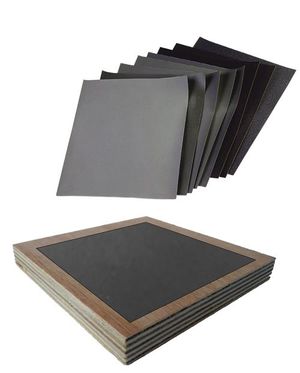Wet or Dry Paper: Difference between revisions
From DT Online
m (Added category links) |
m (Added Amazon Link) |
||
| (3 intermediate revisions by the same user not shown) | |||
| Line 1: | Line 1: | ||
<div class="floatright"><dtamazon type="search" search="Wet and Dry Paper"><img alt="WetDryPaper.jpg" src="/images/thumb/3/30/WetDryPaper.jpg/300px-WetDryPaper.jpg" width="300" height="373" srcset="/images/thumb/3/30/WetDryPaper.jpg/450px-WetDryPaper.jpg 1.5x, /images/3/30/WetDryPaper.jpg 2x" /></a></dtamazon></div> | |||
__TOC__ | |||
=====Description===== | |||
[http://en.wikipedia.org/wiki/Silicon_carbide#Abrasive_and_cutting_tools '''Silicon Carbide'''], or '''Wet and Dry''', paper is available in a very wide range of [http://en.wikipedia.org/wiki/Sandpaper#Grit_sizes '''grit sizes'''] - eg up to 3000. Use wet 40 to 600 grit for general finishing of metals and plastics and 1000 and above for cutting back between coats of spray paint. | |||
<span style="color: green">'''Note:''' | <span style="color: green">'''Note:''' | ||
Using Wet and Dry Paper wet will prolong its life and makes for a better finish. Adding a drop of washing-up liquid to the bowl of water being used will also help lubricate the paper. | Using Wet and Dry Paper wet will prolong its life and makes for a better finish. Adding a drop of washing-up liquid to the bowl of water being used will also help lubricate the paper. | ||
</span> | </span> | ||
Wrap around strips of wood when finishing edges of plastics and clip to a sanding block when finishing large surfaces | =====Features and Applications===== | ||
Wrap around strips of wood when finishing edges of plastics and clip to a sanding block when finishing large surfaces ''(e.g. when rubbing down sprayed painted panels between coats)'' and alternate the direction to remove scratches. | |||
Sheets of Wet and Dry paper can be fixed to '''[[Manufactured Board|waterproof ply]]''' to make graded sanding boards for finishing edges and small pieces of work - e.g. 120 grit, 240 grit and 400 grit. | Sheets of Wet and Dry paper can be fixed to '''[[Manufactured Board|waterproof ply]]''' to make graded sanding boards for finishing edges and small pieces of work - e.g. 120 grit, 240 grit and 400 grit. | ||
{{Abrasives Buyers Guide}} | |||
[[Category:Primary]] | [[Category:Primary]] | ||
[[Category:Secondary]] | [[Category:Secondary]] | ||
[[Category:Tools | [[Category:Shaping, Abrading and Finishing Tools]] | ||
Latest revision as of 13:55, 7 November 2017
Description
Silicon Carbide, or Wet and Dry, paper is available in a very wide range of grit sizes - eg up to 3000. Use wet 40 to 600 grit for general finishing of metals and plastics and 1000 and above for cutting back between coats of spray paint.
Note:
Using Wet and Dry Paper wet will prolong its life and makes for a better finish. Adding a drop of washing-up liquid to the bowl of water being used will also help lubricate the paper.
Features and Applications
Wrap around strips of wood when finishing edges of plastics and clip to a sanding block when finishing large surfaces (e.g. when rubbing down sprayed painted panels between coats) and alternate the direction to remove scratches.
Sheets of Wet and Dry paper can be fixed to waterproof ply to make graded sanding boards for finishing edges and small pieces of work - e.g. 120 grit, 240 grit and 400 grit.










